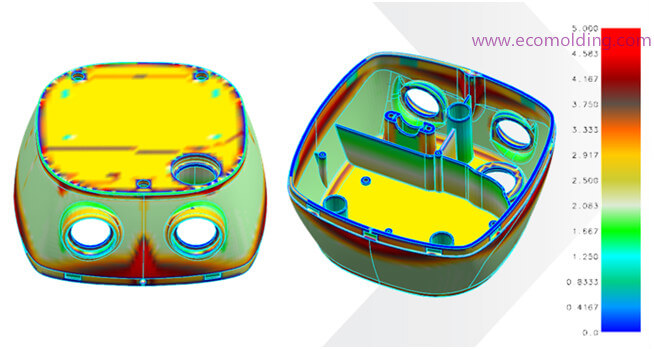When designing a plastic part, its wall thickness must be carefully identified by properly considering the balance among weight, geometry and budget. For instance, though the thick plastic walls offer greater strength, they tend to warp when cooled in the manufacturing process. Among all the design elements, the thickness of a wall exerts the largest impact on production cost, efficiency and the quality of the final product.

A Reasonable Wall Thickness for plastic injection molding
While thicker walls are engineered for additional strength, thinner walls are created for some other benefits. As a matter of fact, you can get more benefits by keeping the part thinner and lighter when the production runs longer. As a result, it is of particular importance to maintain the optimum thickness especially for large volume plastic injection molding projects. If you keep the wall as thin as possible, you can get the following benefits:
- Greater warping resistance when cooling
- Lower costs thanks to less material usage and faster production
- Lighter overall weight, thus much easier for handling, management, packaging and shipping
- Shorter cooling cycles for faster and more efficient production
The wall thickness of a part is subject to no restrictions at all, but generally speaking, our ultimate goal would be to create a wall that is as thin as possible while also taking the structural requirements, overall dimensions and the geometry of a part into consideration. Another factor to be considered is the flow behavior and qualities of the resin materials.
Ensuring a Uniform Wall Thickness
During the injection molding process, a consistent thickness is of critical importance to cooling; if some parts of a product are thinner or thicker than the rest, the product might not be strong enough to withstand warping, cracking, twisting and overall failure. A consistent wall thickness is able to minimize shrinkage rate, as well as residual stress of the final product.
If a fully uniform wall thickness is not possible, it is better to maintain gradual thickness variations, so as to maintain design stability. For a product made from high mold shrinkage plastic materials, the variations in wall thickness should not exceed 10%, even with gradual variations to cope with possible stress concentrations.
A consistent wall thickness is also able to guarantee that the resin flows through a tool in the most efficient and uniform way, so as to achieve ideal processing. On the other hand, if there are variations in the wall thickness, air trapping, unbalanced filling and weld lines might be caused, as the molten plastic tends to take preferential flows.
Recommended Wall Thickness By Plastic Resin Types
| Resin Type | Wall Thickness(mm) |
| Acrylic(PMMA) | 0.635-3.81 |
| Polypropylene(PP) | 0.635-3.81 |
| Acetal(Delrin,POM) | 0.762-3.048 |
| Polystyrene(PS) | 0.889-3.81 |
| Polycarbonate(PC) | 1.016-3.81 |
| Acylonitrile Butadiene Styrene(ABS) | 1.143-3.556 |
| Nylon(PA) | 0.762-2.921 |
| Polyethylene(PE) | 0.762-5.08 |
| Polyurethane(PU) | 2.032-19.05 |
| Polyphenylene Sulfide(PPS) | 0.508-4.572 |
| Polybutylene Terephthalate(PBT) | 2.032-6.35 |
| Rigid PVC | 2.286-6.35 |
| Soft PVC | 0.635-3.81 |
